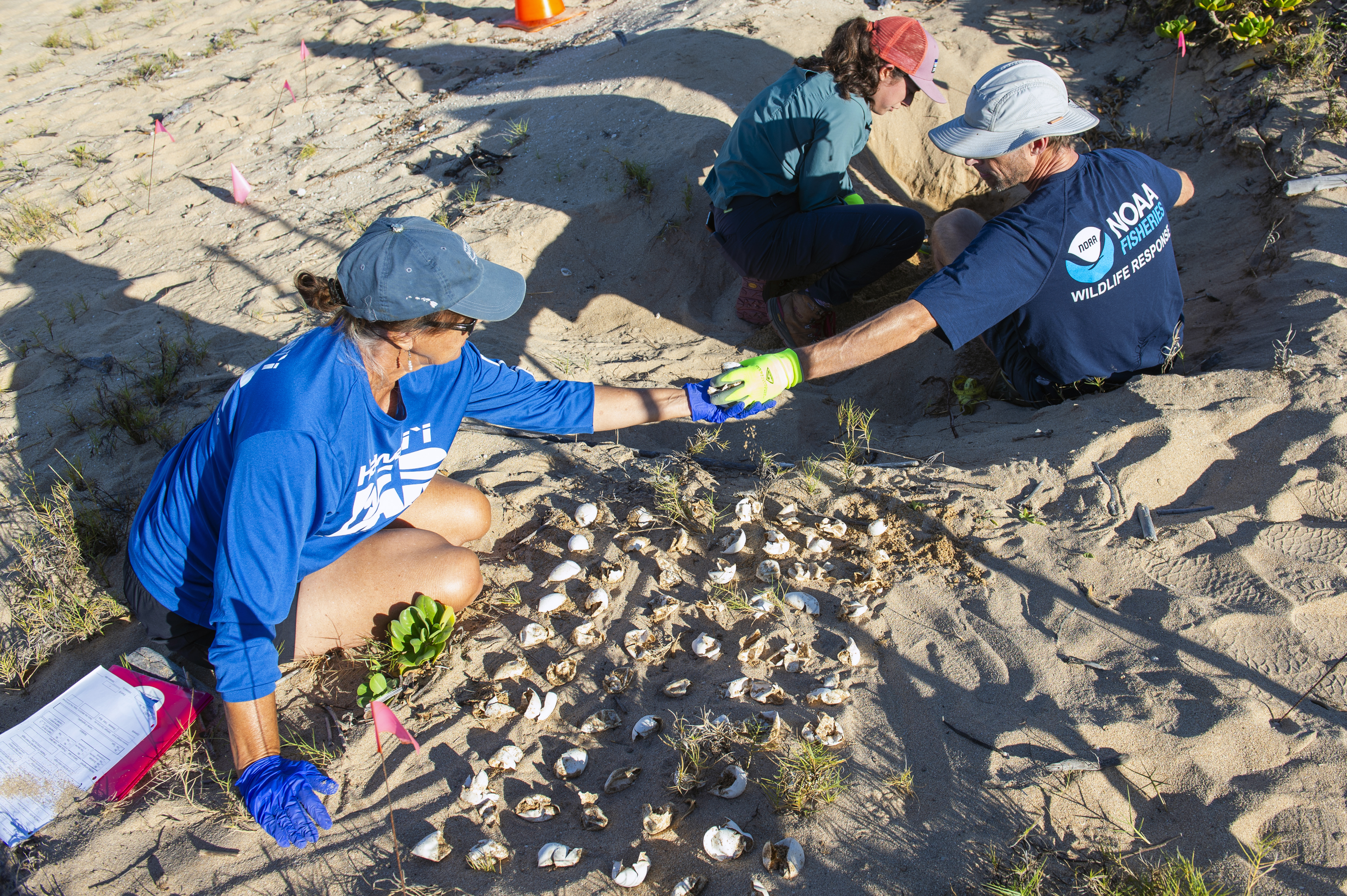The turtle crawled its way to the sandy incline, dragging what could be its 300-pound body or so to the ideal spot for a nest. Flapping its flippers and tossing sand aside, it dug a hole and deposited 80 ping-pong-ball-sized eggs. With this solitary mission complete, momma turtle returned back into the surf.
With daylight revealing the telltale evidence in the sand, biologists at PMRF cordoned off that area on the southern end of the airfield … and waited.
The team of partners working with PMRF include the United States Department of Agriculture (USDA), the Pacific Cooperative Study Unit at the University of Hawaii, the Hawaii Department of Land and Natural Resources (DLNR) Division of Aquatic Resources (DAR), and the National Oceanic and Atmospheric Administration (NOAA).
After the eggs incubated in the warm sand for 56 days, the much-anticipated moment arrived, confirmed by the tracks leading to the water. “The airfield green sea turtle nest hatched last night!” PMRF Natural Resources Manager Brooke McFarland announced Sept. 14.
Green sea turtles nest on beaches in the general area of where they had hatched years earlier. The shoreline at PMRF is ideal for nests, since it is a protected and quiet location with limited human activity and light pollution. Turtle nesting season in Hawaii runs from mid-April to September, but can extend into December.
“It is always an exciting event when a nest hatches, knowing we did our part to protect this majestic creature and aid in the survival of this animal that is protected under the Endangered Species Act,” Stephen Rossiter, the natural resources field coordinator for PMRF, said.
Sea turtles emerge from their nest en masse, oftentimes under the cover of darkness to avoid predators. The babies rush to the brightest spot in the horizon as quickly as their little flippers will take them, moving away from the dark silhouettes of the dunes and vegetation.
Green sea turtles, which are found around the world, face danger as a result of artificial lights that can cause nesting mothers or hatchlings to move toward artificial light inland, instead of the ocean, and into danger where they face dehydration, car strikes, predators, exhaustion and possible death.
Many other dangers exist: turtles can become entangled in fishing nets, be injured or killed in vessel strikes, face degradation of ocean and nesting habitats, ingest marine pollution that injures or kills them, succumb to disease, or be the target of illegal poaching and even in some countries the legal harvesting of turtles and their eggs.
“These honu (sea turtles) face many threats so it is great news that we at PMRF could provide a safe place for this nest, away from predators, and free of the light pollution that can disorient hatchlings as they make their way to the sea,” Rossiter said.
A week after the nest hatched, PMRF biologists Katy Finney and Daniela Casillas excavated the nest with Mimi Olry, DLNR’s Kauai Marine Mammal Response Coordinator, and Jamie Thomton, NOAA’s Kauai Marine Mammal Response Coordinator.
Casillas and Thomton began digging the spot, finding one … then two … then six … then 20 … then more. The biologists discovered 76 hatched eggs, and four unhatched, not viable eggs.
This has been the only sea turtle nest on the installation this year, Rossiter said, explaining the biologists did a careful search the morning after the hatching and did not find any wayward turtles, leading them to believe the 76 babies made it to the ocean.
The biologists describe this as a very successful nest.
When the work was complete and all the data logged, the biologists removed the turtle nest signs, and gently returned the contents of the nest back into the warm sand on this quiet and undisturbed beach, with the hope that some of the babies will one day return to the area to again be a part of this cycle of life.
Images Available here: 
Biologists with Pacific Missile Range Facility and partners with the Hawaii Department of Land and Natural Resources and the National Oceanic and Atmospheric Administration excavate a green sea turtle nest and discover 76 hatched eggs and four nonviable eggs, at PMRF Barking Sands, Hawaii, Sept. 22, 2023. This was the only honu (sea turtle) nest on the installation this year, said Stephen Rossiter, the natural resources field coordinator for PMRF. The assumption, he said, is that the 76 babies made it to the ocean. In this photo, Mimi Olry, the Kauai Marine Mammal Response Coordinator with the Hawaii Department of Land and Natural Resources, arranges the eggs during the excavation. (U.S. Navy photo by Lisa Ferdinando)
###